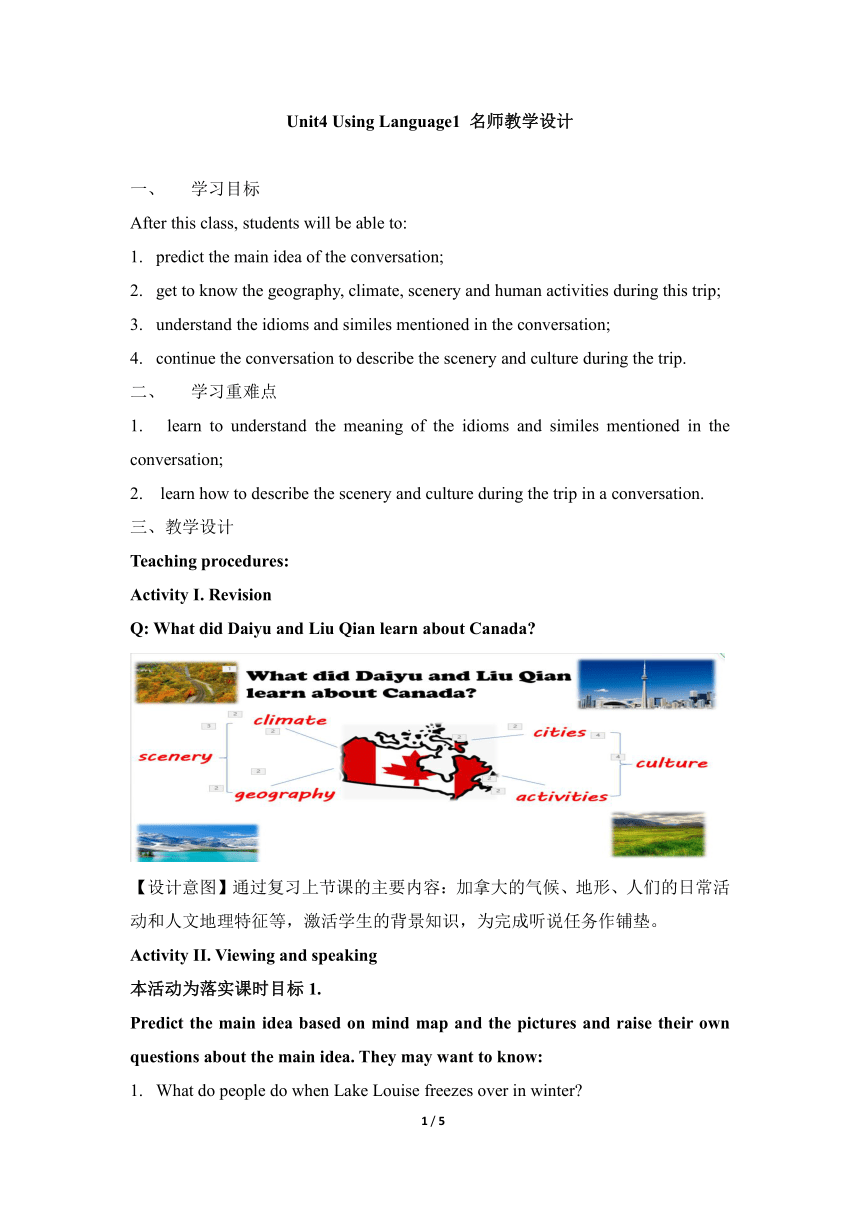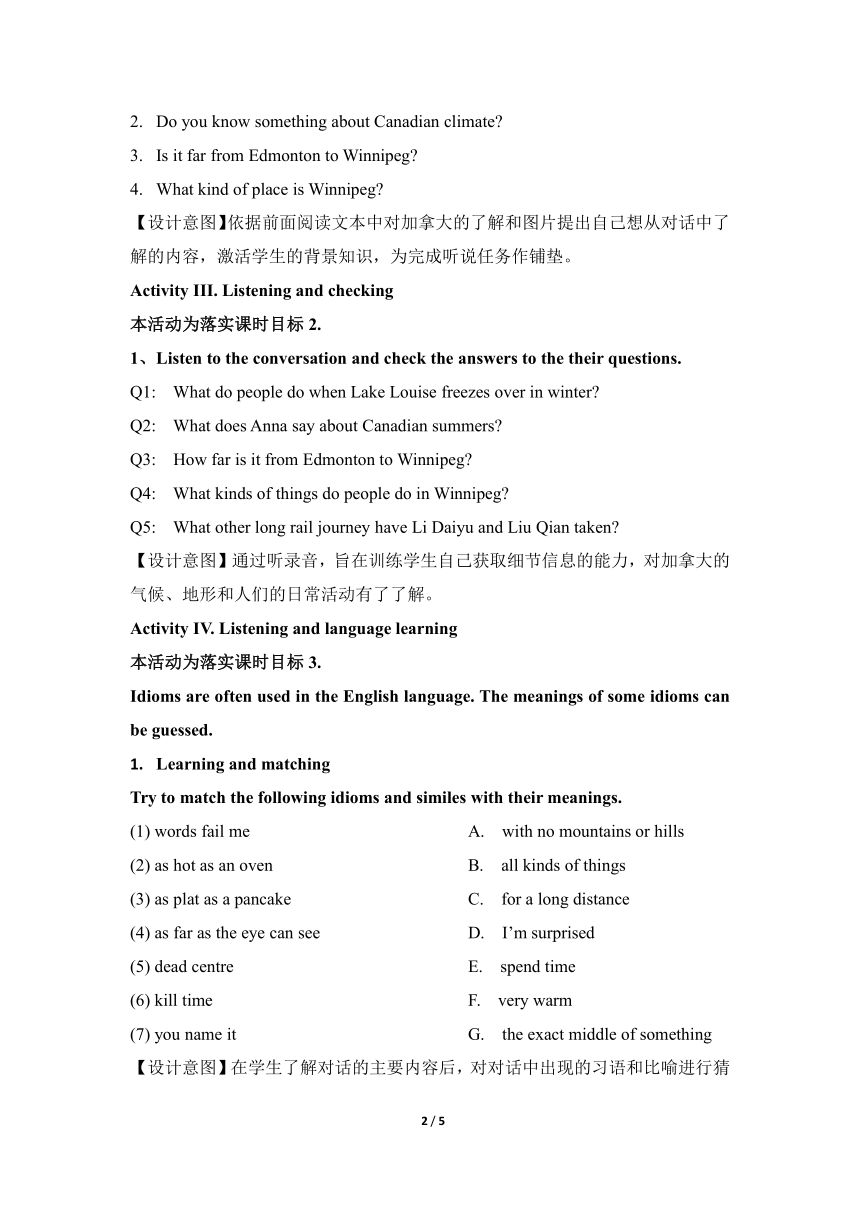人教版(2019)高中英语选择性必修第二册 Unit4 Journey Across a Vast Land Using Language1 名师教学设计
文档属性
| 名称 | 人教版(2019)高中英语选择性必修第二册 Unit4 Journey Across a Vast Land Using Language1 名师教学设计 |

|
|
| 格式 | docx | ||
| 文件大小 | 1.4MB | ||
| 资源类型 | 教案 | ||
| 版本资源 | 人教版(2019) | ||
| 科目 | 英语 | ||
| 更新时间 | 2023-03-12 18:03:43 | ||
图片预览


文档简介
Unit4 Using Language1 名师教学设计
学习目标
After this class, students will be able to:
predict the main idea of the conversation;
get to know the geography, climate, scenery and human activities during this trip;
understand the idioms and similes mentioned in the conversation;
continue the conversation to describe the scenery and culture during the trip.
学习重难点
1. learn to understand the meaning of the idioms and similes mentioned in the conversation;
2. learn how to describe the scenery and culture during the trip in a conversation.
三、教学设计
Teaching procedures:
Activity I. Revision
Q: What did Daiyu and Liu Qian learn about Canada
【设计意图】通过复习上节课的主要内容:加拿大的气候、地形、人们的日常活动和人文地理特征等,激活学生的背景知识,为完成听说任务作铺垫。
Activity II. Viewing and speaking
本活动为落实课时目标1.
Predict the main idea based on mind map and the pictures and raise their own questions about the main idea. They may want to know:
What do people do when Lake Louise freezes over in winter
Do you know something about Canadian climate
Is it far from Edmonton to Winnipeg
What kind of place is Winnipeg
【设计意图】依据前面阅读文本中对加拿大的了解和图片提出自己想从对话中了解的内容,激活学生的背景知识,为完成听说任务作铺垫。
Activity III. Listening and checking
本活动为落实课时目标2.
1、Listen to the conversation and check the answers to the their questions.
Q1: What do people do when Lake Louise freezes over in winter
Q2: What does Anna say about Canadian summers
Q3: How far is it from Edmonton to Winnipeg
Q4: What kinds of things do people do in Winnipeg
Q5: What other long rail journey have Li Daiyu and Liu Qian taken
【设计意图】通过听录音,旨在训练学生自己获取细节信息的能力,对加拿大的气候、地形和人们的日常活动有了了解。
Activity IV. Listening and language learning
本活动为落实课时目标3.
Idioms are often used in the English language. The meanings of some idioms can be guessed.
Learning and matching
Try to match the following idioms and similes with their meanings.
(1) words fail me A. with no mountains or hills
(2) as hot as an oven B. all kinds of things
(3) as plat as a pancake C. for a long distance
(4) as far as the eye can see D. I’m surprised
(5) dead centre E. spend time
(6) kill time F. very warm
(7) you name it G. the exact middle of something
【设计意图】在学生了解对话的主要内容后,对对话中出现的习语和比喻进行猜测。旨在训练学生在根据语境猜测英语习语。
Listening for details
(1)Listen to the conversation and fill in the blanks. In the meantime, get the meanings of the idioms and similes based on the context.
【设计意图】将对话根据谈论主要内容气候、风景、地貌特征和人们活动分成三部分,让学生通过对话中的上下文理解其中运用的习语和比喻,同时也能关注感知表示吃惊好奇、谈论空间位置的语言, 并为后面的续编对话积累语言。
(2)Q1: What is talked about in this part (Geography through Mongolia)
Q2: What have you learnt from the conversation (scenery and culture in Canada )
Q3: Do you think they have finished their conversation
【设计意图】对话的第三部分是介绍Liu Qian和Daiyuyan的其他旅行来谈论加拿大之外的风景和文化。此外引导学生关注这个变化,为下面的续编对话做好铺垫。
Listening and predicting
Read the following part of the conversation and predict what will be talked about next.
【设计意图】为下文续编对话做好铺垫: a vast and empty place in China, its amazing scenery and culture.
Activity V. Speaking
本活动为落实课时目标3.
Brainstorm the scenery and culture in Tibet.
【设计意图】运用图片介绍西藏作示范,激活续编对话的积极性。
Role play the sample. Note the expressions about surprise, space and position, scenery and culture. Learn to end the conversation naturally.
Language learning
Q: How can we end our conversation naturally
【设计意图】分角色sample,让学生感知关于吃惊好奇、方位、风景文化的表达,自然结束对话的表达。
Make a conversation about the travel you’ve taken in China. (group work)
Focus on the scenery and culture there.
Try to use the useful expressions learnt in the conversation.
【设计意图】通过小组讨论,激活学生旅行经历,引导学生使用听力中积累的关于吃惊好奇、方位、风景文化和自然结束对话的表达。
Activity VI. Assignment:
Make sentences with the idioms learnt today.
Build the word bank based on the mind map.
【设计意图】让学生创设情境使用本课中习得的习语和比喻等表达,并根据话题构建词汇语义网。为下个课时描写一次旅行经历做好铺垫。
2 / 2
学习目标
After this class, students will be able to:
predict the main idea of the conversation;
get to know the geography, climate, scenery and human activities during this trip;
understand the idioms and similes mentioned in the conversation;
continue the conversation to describe the scenery and culture during the trip.
学习重难点
1. learn to understand the meaning of the idioms and similes mentioned in the conversation;
2. learn how to describe the scenery and culture during the trip in a conversation.
三、教学设计
Teaching procedures:
Activity I. Revision
Q: What did Daiyu and Liu Qian learn about Canada
【设计意图】通过复习上节课的主要内容:加拿大的气候、地形、人们的日常活动和人文地理特征等,激活学生的背景知识,为完成听说任务作铺垫。
Activity II. Viewing and speaking
本活动为落实课时目标1.
Predict the main idea based on mind map and the pictures and raise their own questions about the main idea. They may want to know:
What do people do when Lake Louise freezes over in winter
Do you know something about Canadian climate
Is it far from Edmonton to Winnipeg
What kind of place is Winnipeg
【设计意图】依据前面阅读文本中对加拿大的了解和图片提出自己想从对话中了解的内容,激活学生的背景知识,为完成听说任务作铺垫。
Activity III. Listening and checking
本活动为落实课时目标2.
1、Listen to the conversation and check the answers to the their questions.
Q1: What do people do when Lake Louise freezes over in winter
Q2: What does Anna say about Canadian summers
Q3: How far is it from Edmonton to Winnipeg
Q4: What kinds of things do people do in Winnipeg
Q5: What other long rail journey have Li Daiyu and Liu Qian taken
【设计意图】通过听录音,旨在训练学生自己获取细节信息的能力,对加拿大的气候、地形和人们的日常活动有了了解。
Activity IV. Listening and language learning
本活动为落实课时目标3.
Idioms are often used in the English language. The meanings of some idioms can be guessed.
Learning and matching
Try to match the following idioms and similes with their meanings.
(1) words fail me A. with no mountains or hills
(2) as hot as an oven B. all kinds of things
(3) as plat as a pancake C. for a long distance
(4) as far as the eye can see D. I’m surprised
(5) dead centre E. spend time
(6) kill time F. very warm
(7) you name it G. the exact middle of something
【设计意图】在学生了解对话的主要内容后,对对话中出现的习语和比喻进行猜测。旨在训练学生在根据语境猜测英语习语。
Listening for details
(1)Listen to the conversation and fill in the blanks. In the meantime, get the meanings of the idioms and similes based on the context.
【设计意图】将对话根据谈论主要内容气候、风景、地貌特征和人们活动分成三部分,让学生通过对话中的上下文理解其中运用的习语和比喻,同时也能关注感知表示吃惊好奇、谈论空间位置的语言, 并为后面的续编对话积累语言。
(2)Q1: What is talked about in this part (Geography through Mongolia)
Q2: What have you learnt from the conversation (scenery and culture in Canada )
Q3: Do you think they have finished their conversation
【设计意图】对话的第三部分是介绍Liu Qian和Daiyuyan的其他旅行来谈论加拿大之外的风景和文化。此外引导学生关注这个变化,为下面的续编对话做好铺垫。
Listening and predicting
Read the following part of the conversation and predict what will be talked about next.
【设计意图】为下文续编对话做好铺垫: a vast and empty place in China, its amazing scenery and culture.
Activity V. Speaking
本活动为落实课时目标3.
Brainstorm the scenery and culture in Tibet.
【设计意图】运用图片介绍西藏作示范,激活续编对话的积极性。
Role play the sample. Note the expressions about surprise, space and position, scenery and culture. Learn to end the conversation naturally.
Language learning
Q: How can we end our conversation naturally
【设计意图】分角色sample,让学生感知关于吃惊好奇、方位、风景文化的表达,自然结束对话的表达。
Make a conversation about the travel you’ve taken in China. (group work)
Focus on the scenery and culture there.
Try to use the useful expressions learnt in the conversation.
【设计意图】通过小组讨论,激活学生旅行经历,引导学生使用听力中积累的关于吃惊好奇、方位、风景文化和自然结束对话的表达。
Activity VI. Assignment:
Make sentences with the idioms learnt today.
Build the word bank based on the mind map.
【设计意图】让学生创设情境使用本课中习得的习语和比喻等表达,并根据话题构建词汇语义网。为下个课时描写一次旅行经历做好铺垫。
2 / 2
